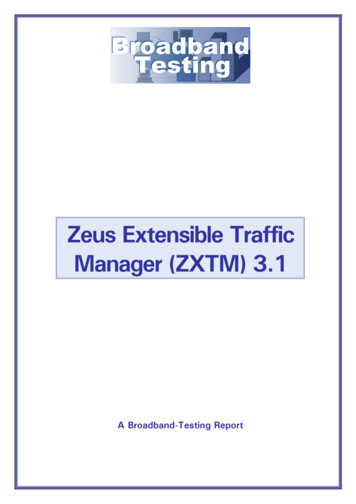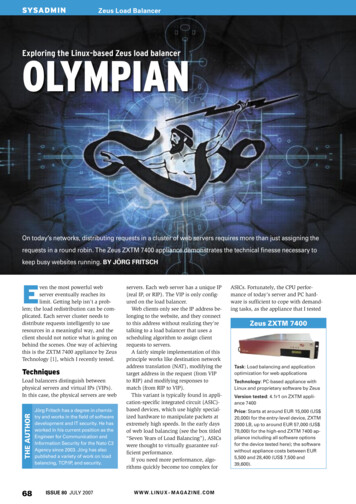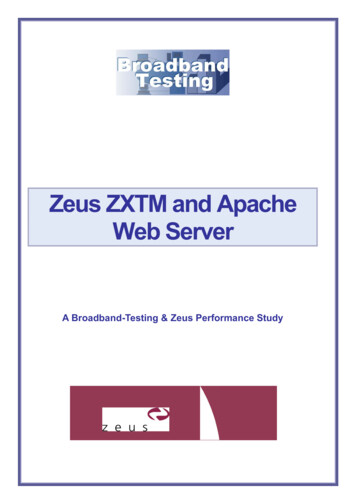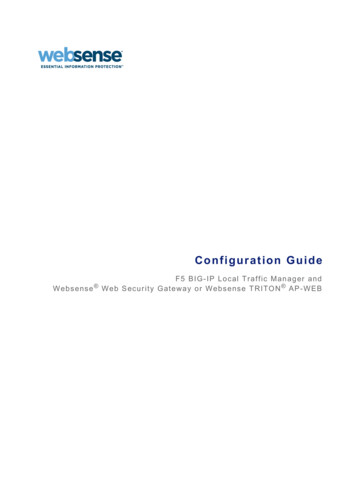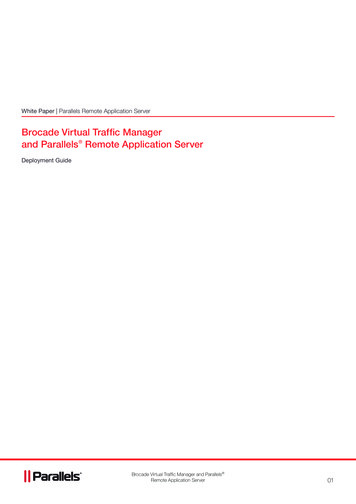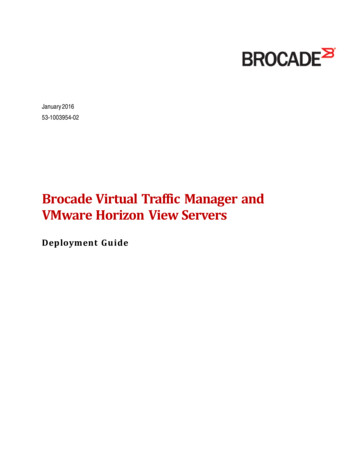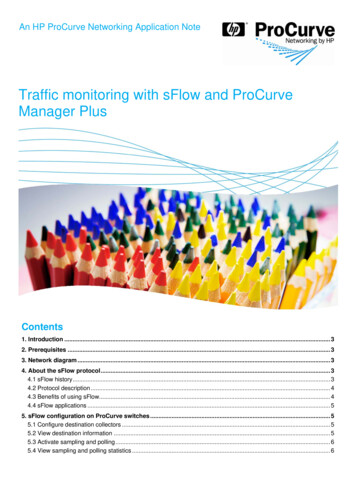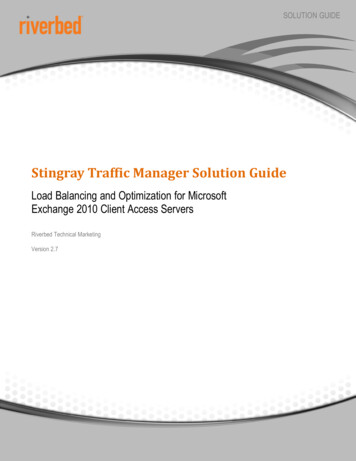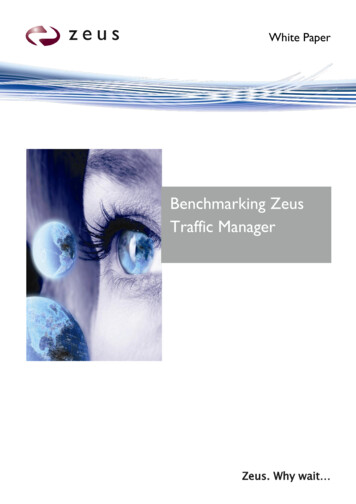
Transcription
White PaperBenchmarking ZeusTraffic ManagerZeus. Why wait
ContentsContents . 2Benchmarking Advice for the Impatient . 3Benchmarking Advice for the more Patient . 41Design your test for ease of use . 42Choose your tests carefully. 5Real-World Benchmarks . 5Comparative Benchmarks . 5Content Compression . 53Begin by sanity-testing the system with a back-to-back run . 64Use a „simultaneous users‟-based test for quick results . 75Understand the use of HTTP Keepalives . 86Disable functionality you do not need . 97Be aware of the effects of slow networks . 98Understand how SSL works . 109Instrument and Monitor your Tests . 1110 Finding out more information . 12Troubleshooting. 13Recommended Hardware Configuration. 14Example Benchmark Configuration . 14Overcoming the 1Gbits/s barrier . 15B e n c h m a r k i n g Z e u s Tr a f f i c M a n a g e rPAGE 2 OF 16Zeus. Why wait.
Benchmarking Zeus Traffic ManagerThis document gives some advice on how to set up accurate, reproducible benchmarks,and how to configure Zeus Traffic Manager for good performance.It is intended foranyone who is considering running benchmark tests against a Zeus Traffic Managersystem.Benchmarking Advice for the ImpatientHere‟s some quick advice:1. Enable Keepalives everywhere:In the benchmark client softwareIn the Zeus Traffic Manager virtual server connection management settingsIn the Zeus Traffic Manager pool connection management settingsIn the back-end server software. unless you explicitly do not want to use Keepalives.2. Test a configuration that is similar to the one you intend to use in production, andexercise it properly.Artificial tests like „HTTP accepts per second‟ do not reveal the true performance of thesystem under test, as they can take advantage of fast-paths that cannot be used in areal deployment.Construct a test that truly exercises the Layer-7 processing capability of your loadbalancer, as that is what you will be using in practice.3. For SSL tests, use a 1024 bit SSL key, unless you absolutely need to use a 2048 bitone.4. Double-check that you have disabled:Access LoggingIP TransparencyContent CompressionService Protection PolicyAny request and response rules that are not required unless you need explicitly them.5. Use 'Round Robin' or 'Least Connections' for the load-balancing method.6. Check the performance tunables on the system against the following 5/09/02/tuning zxtm for maximum performance7. When running a benchmark, double and triple check where the bottleneck is. If ZeusTraffic Manager is not running at 100% CPU, you are not stressing it hard enough andthe test is insufficient. „vmstat 3‟ is a good tool to use.B e n c h m a r k i n g Z e u s Tr a f f i c M a n a g e rPAGE 3 OF 16Zeus. Why wait.
Benchmarking Advice for the more Patient1 Design your test for ease of useBenchmarking is very tedious. Design your tests so that you can explore the performanceenvelopes easily and quickly, and so that your tests are repeatable:Where ever possible, script your tests.If you are using software load generators like ApacheBench or ZeusBench, spend alittle time building a scriptable test harness so that you can run your standard testswith different parameters and record the results.Additional frameworks can run your test scripts repeatedly with different parameters,making repeated tests much easier to conduct.Save the scripts so that you can replay the testsYou‟re almost certain to discover something several days in to a benchmarking activitythat means you want to rerun some of your earlier tests.Keep the tests as simple as possible, so that you can easily determine what you aremeasuring, and can easily interpret the results. Do not be too ambitious in your design!If you are using a sophisticated benchmarking tool like Spirent Avalanche or MercuryLoadRunner, investigate how you can archive test specifications and results.Do remember to take copious notes whenever you run a test. Things that seem clear atthe time are quickly forgotten in the deluge of numbers that follow after.B e n c h m a r k i n g Z e u s Tr a f f i c M a n a g e rPAGE 4 OF 16Zeus. Why wait.
2 Choose your tests carefullyThe biggest benchmarking challenge is to choose the tests correctly so that you measurewhat you want to measure, and you do like-for-like tests.The tests will vary depending on your goals:Real-World BenchmarksIf you want to find the optimal configuration for a known real-world environment, try andreplicate this environment as simply as possible. If necessary, construct several differenttests to replicate the different scenarios in the environment.For example, real-world environments have slow, lossy networks with many clients and awide range of request types and speeds.Trying to replicate all cases will result in acomplex, hard to build test where the results are hard to interpret.Rather then trying to replicate the entire range of clients, run several simple tests witheach class of client – for example, different file sizes, requests types and network speeds.Determine the optimal configuration for each scenario, then chose a common configurationthat works well for all of these scenarios.Comparative BenchmarksIf you are performing comparative benchmarks against a competing product, be awarethat low-level tests do not play to Zeus Traffic Manager‟s strengths, and they do not givean accurate measurement of any product‟s performance.In Zeus Traffic Manager, all traffic is processed at layer 7.All HTTP requests andresponses are disassembled, inspected and reassembled as they pass through the system.Any layer 7 tasks can then be processed with ease.Many other load balancers have layer 4 fast paths which optimize their performance insimple „connections-per-second‟ benchmarks.These benchmarks do not give a trueindication of performance in a real environment where layer-7 functionality must be used.For example, even something as simple as a session persistence mode that adds a cookieinto the response needs layer-7 functionality.So, if your expected deployment of the load balancer will use any sort of layer-7processing, make sure that you set a level playing field by including layer-7 processingtasks in your benchmark.A simple way to do this would be to configure each loadbalancing device to add or rewrite an HTTP header in each request and seaconfigurationrepresentative of the configuration you would use in a real-world deployment.thatisManypublished benchmarks are misleading precisely because they do not, using 0-byte files tomeasure HTTP connections-per-second, or 100Mb files to measure maximum throughput.Content CompressionOne of the most misleading sets of benchmarks relate to content compression.Compression performance depends critically on the nature of the data being compressed.Beware of over-inflated published figures that used files containing just „*‟ as the payloadto be compressed!B e n c h m a r k i n g Z e u s Tr a f f i c M a n a g e rPAGE 5 OF 16Zeus. Why wait.
3 Begin by sanity-testing the system with a back-to-back runIt‟s important to ensure that your test setup is adequate. Begin your testing with a backto-back test where you point your client directly at the server. This will validate whetherthe system is correctly configured, and will highlight any bottlenecks on the system.Check the CPU usage of your clients.If your clients are running at 100%, this gives an upper bound on the maximum testperformance.You may not be able to reach the limits of the Zeus Traffic Managersystem you will benchmark in subsequent tests. Consider adding more clients so thatyou have sufficient power to drive the test harder.Check the CPU usage of your servers.If they are running at 100%, this also gives an upper bound on the maximum testperformance. You may want to add more servers.Zeus Traffic Manager‟sapplication acceleration capabilities can squeezeextraperformance out of a server, and Zeus Traffic Manager allows you to run your testagainst a cluster of servers if you need additional server capacity.Check your network capacity.Run a back-to-back test that involves large file transfers (HTTP GETs for a 100Mb filefor example) so that you can saturate the network. Provided that neither your clientsnor servers are maxed out (running at 100% CPU), the network transfer rate youachieve should correspond to the network‟s capacity.For example, on a 1 Gbits network, you should be able to achieve about 960 to 980Mbits of HTTP traffic.Once you know where the bottleneck in your system is, and the maximum transactionsyou can expect, you‟re ready to start testing Zeus Traffic Manager thoroughly. During thetest, keep an eye on the CPU usage of Zeus Traffic Manager – if it‟s not 100%, you‟re notdriving it hard enough!The „vmstat‟ tool (run „vmstat 3‟ in a console window) is a lightweight way of monitoringCPU usage; your test should keep the Zeus Traffic Manager idle time to 0%.B e n c h m a r k i n g Z e u s Tr a f f i c M a n a g e rPAGE 6 OF 16Zeus. Why wait.
4 Use a ‘simultaneous users’-based test for quick resultsThere are a number of different ways you can load up the system under test:Connection Rate tests issue connections at a fixed rate;Bandwidth tests try to saturate a configured bandwidth amount;Simultaneous Users tests create a set of „users‟ who each issue one request at a time;Variations include tests which create users at a fixed rate, each of which issue anumber of requests in sequence.When trying to discover the maximum capacity of the system under test, you will need todecide on the parameters that control the connection rate, simultaneous users, etc., inorder to determine the highest transaction-per-second rate the system can sustain.Connection Rate and Bandwidth tests will under-stress the system if they issue fewerrequests than the system‟s capacity, and will greatly over-stress the system if they issuerequests at a greater rate then the system can sustain:Achieved TPS against Request Rate1400Response Rate 01600Request RateTo get the maximum performance from the system, you have to determine the narrow„sweetspot‟ where it performs at its best.Simultaneous User-based tests are a lot more forgiving and are less likely to under- orover-stress the system.They will settle into issuing requests at precisely the rate thesystem can sustain:Achieved TPS against Simultaneous Users1200Response Rate erimentingSimultaneous ferentconfigurations, use Simultaneous Users-based tests for more rapid, accurate, reproducibleresults.Note that ApacheBench‟s default mode of operation is like „Simultaneous Users‟. The –cconcurrency flag controls the number of users, each of which issue requests repeatedly.B e n c h m a r k i n g Z e u s Tr a f f i c M a n a g e rPAGE 7 OF 16Zeus. Why wait.
5 Understand the use of HTTP KeepalivesThere are a lot of misconceptions surrounding HTTP keepalives.Keepalives give asignificant performance benefit (between 60% and 150% depending on circumstances),but conventional wisdom is to disable them on thread-or-process based servers likeApache.Server-side Keepalives (Zeus Traffic Manager Pool Configuration)Zeus Traffic Manager maintains a small pool of very active keepalive connections tothe local servers. It is safe and highly beneficial to use keepalives to the servers –configure your Zeus Traffic Manager HTTP pools to use Keepalives (in the ConnectionManagement section of the configuration), and your benchmark servers. Because ofthe way that Zeus Traffic Manager functions, it avoids the detrimental circumstancesthat cause Apache or similar servers to underperform.Client-side Keepalives (Zeus Traffic Manager Virtual Server Configuration)You should always enable client-side keepalives in a real-world configuration of ZeusTraffic Manager.This results in better response times and higher performance, andZeus Traffic Manager does not suffer from the well documented Keepalive scalabilityproblems that affect servers like Apache.Therefore, you should enable client-side keepalives on your Zeus Traffic ManagerVirtual Server configuration, and configure your test clients to use keepalives.B e n c h m a r k i n g Z e u s Tr a f f i c M a n a g e rPAGE 8 OF 16Zeus. Why wait.
6 Disable functionality you do not needAccess Logging, Service Protection Policies, Content Compression and IP Transparency canall have a detrimental effect on performance.Disable these features unless they arerequired in the test.On the other hand, content caching will dramatically improve the test results you get!In practice, it is best to begin with the default configuration (a new virtual server and pool,and the defaults restored on the global settings page) and then step by step, apply theconfiguration you need for your service (such as TrafficScript rules).Once you have aworking basic service, use the configuration backup to archive it before you startexperimenting.Once you start to experiment with performance tweaks, you can use the configurationbackup tools to compare your running configuration with the backed up one.This practice helps to avoid common mistakes, such as accidentally configuring a featureand then forgetting to remove it during benchmarking.On a related note, the „Round Robin‟ and „Least Connections‟ load-balancing methods arethe quickest (though there is not much in it). If all your back-end servers are identical,use Round Robin; if they differ in capacity, use „Least Connections‟.7 Be aware of the effects of slow networksSlow networks have a dramatic effect on the performance of thread or process basedservers like Apache.Transaction Rates for various network latencies8000Transactions per Second700060005000Zeus4000Apache (no KA)Apache (with KA)3000200010000050100150200250300350400Network Round Trip TimeIf you wish to measure the acceleration capabilities of Zeus Traffic Manager with theseservers, it‟s essential that you include a means of adding network latency into your testsystem. Zeus‟ tests have used a Linux gateway machine with the Netem kernel module toapply a range of network B e n c h m a r k i n g Z e u s Tr a f f i c M a n a g e rPAGE 9 OF 16Zeus. Why wait.
8 Understand how SSL worksZeus Traffic Manager is particularly strong at decrypting and encrypting SSL traffic, but itis easy to misconfigure an SSL test and get inaccurate results.Know your key size and ciphersThe size of the RSA key in the public/private certificate will govern the rate at whichZeus Traffic Manager can decrypt SSL traffic.The majority of public benchmarks and performance figures use 1024 bit keys. Theseare sufficiently strong for public SSL sessions.Higher strength keys are used inenvironments where a compromise would be devastating – certificate authorities use2048 or 4096 bit root keys for example.A larger key will reduce the SSL performance. Tests indicate that a 2048 bit key givesabout 25% the performance of a 1024 bit one.An SSL session can select which ciphers to use. All SSL clients support the standard128-bit RC4-MD5 cipher.If you can configure the cipher your client software uses,select this one.Understand SSL Session ReuseAn SSL client can reuse an already-established SSL session.This gives enormousperformance improvements – up to 10 times the transactions-per-second. Real-worldweb browser clients always reuse sessions whenever possible.In the simple SSL performance test, disable session reuse in your client test system,and disable Zeus Traffic Manager‟s external SSL session ID cache in the GlobalSettings part of the configuration.If you do wish to test the effects of session reuse, be aware that proportion ofconnections that reuse a session ID will affect the performance figures you get. Youwill need to fix this proportion in order to get stable, reproducible figures, and you mayneed to size Zeus Traffic Manager‟s external SSL session ID cache accordingly.In a recent test using Spirent clients, a „connection rate test‟ was used that had nocontrol over session reuse. As the connection rate and response time increased, theclient software prioritized new SSL connections over established SSL sessions, so fewerSSL session IDs were reused. This gave inconsistent, useless results!B e n c h m a r k i n g Z e u s Tr a f f i c M a n a g e rPAGE 10 OF 16Zeus. Why wait.
9 Instrument and Monitor your TestsZeus Traffic Manager has very capable visualization tools in the web-based UI. You caneasily monitor a wide range of values, and this is very useful when determining whether atest is functioning as expected or not.Keepalive ReuseUse the activity monitor to graph the rate of connections to several of your nodes.Compare the number of new connections against the number of connections that reusean existing keepalive connection.This will confirm whether server-side connections are being used or not.You can do similar checks for client side keepalive connections.SSL Session ID reuseLikewise, in an SSL test, you can chart the number of transactions per second theZeus Traffic Manager performed, and compare this with figures on RSA operations persecond (i.e., full SSL handshakes), SSL session ID cache hits and SSL session ID cachemisses.Zeus Traffic Manager‟s monitoring performs a useful sanity check, but it also reduces theperformance of the system by a noticeable amount. For final, top-end performance figuresdo not interactively monitor the performance of the Zeus Traffic Manager system. Beforeany final tests, log on to the Zeus Traffic Manager system and issue the command„killall miniperl‟ to safely terminate any data collection processes.You can safely run a command like „vmstat 3‟ on the Zeus Traffic Manager system duringa test to monitor the CPU user, system and idle time.This has minimal impact on theperformance and gives a useful indication as to whether or not the Zeus Traffic Managersystem is maxed out (idle time should be 0%).B e n c h m a r k i n g Z e u s Tr a f f i c M a n a g e rPAGE 11 OF 16Zeus. Why wait.
10 Finding out more informationThe Zeus Traffic Manager Kno
Benchmarking Zeus Traffic Manager This document gives some advice on how to set up accurate, reproducible benchmarks, and how to configure Zeus Traffic Manager for good performance. It is intended for anyone who is considering running benchmark tests against a Zeus Traffic

